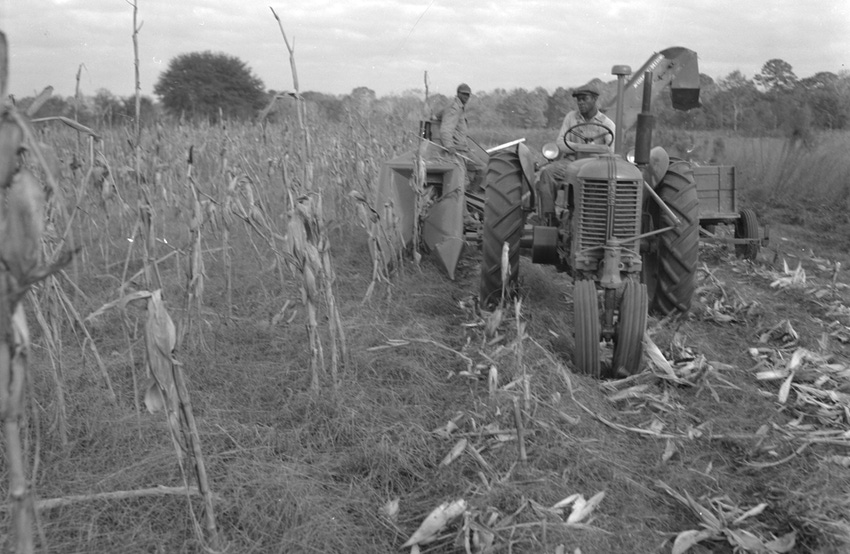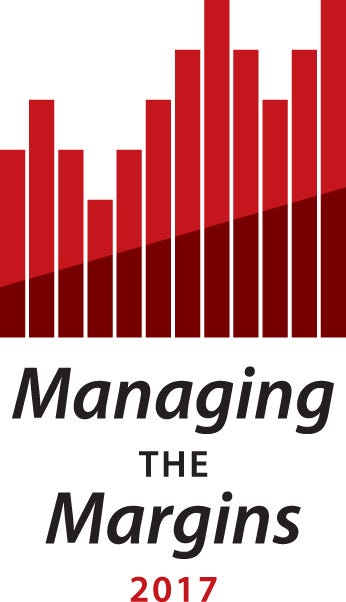
U.S. agriculture is experiencing its fourth distinct recession in the last century. A modern look at the historical paths downturns took can provide insight, and useful reference points, to what the economic landscape might be down the road.
“We just gotta get through the swamp to get to the horizon. But the question is how do we survive now and at the same time position for a bright future?” said Jason Henderson, the director of Purdue Extension and former vice-president at the Federal Reserve Bank of Kansas City, during a standing-room-only session at the 2017 Commodity Classic in San Antonio March 2.
Note from editor: This is the second article of the “Managing the Margins: 2017,” series which will appear in Southeast Farm Press print and digital editions monthly (or more often as needed) to provide up-to-date information and strategies to manage the unique financial risks and opportunities associated with farming in the Southeast in 2017.
This current farm recession seems to have found bottom, or is slightly stabilizing, at least. However, farm revenue will still not cover the costs of production this year for most corn, soybean and wheat operations. Profit margins for producers will be touch-and-go with possibly no meaningful fiscal rebound for another two years or longer.
We’ve been here before but not in the same way. History doesn’t repeat itself but it sure does rhyme, Henderson said, alluding to a quote often 
Agriculture’s current downturn is definite and somewhat textbook. Downturns follow good economic times, sometimes historically good economy times, for farmers. Henderson says agricultural recessions also share two other pronounced components:
There is a liquidity crisis, or what is known as a serious cash-crunch, which often happens when demand falls, usually in the export market, and you get a high exchange rate, or strong dollar. “Doesn’t that represent what is happening today? Demand has plateaued and we have a high-value of the dollar,” he said.
The cash crunch turns into a solvency crisis. “How do farmers respond to having a cash crunch,” he said. “Do you roll that loan? If you want to scare a bank regulator, have your banker go up to him and say, ‘Oh, don’t worry about it; a rolling loan never collects a loss.’”
“How long can you roll that loan? I think it depends on how high inflation goes,” he said. “Because when inflation goes up, what does the Federal Reserve do? It raises interest rates. And what does that do to your debt service? Sends it up. And what does that do to the value of your land? Sends it down. … This is usually the recipe for bankruptcy historically, and I think it’s something we have to think about going forward.”
The Federal Reserve indicates it will continue a pace to hike interest rates this year. Controlling debt will be farmers’ greatest concern as they work their way through this recession over the next few years, Anderson said.
Anderson pointed to U.S. agriculture’s three previous economic downturns. The first happened on the heels of WWI with the Great Depression, the second was a downturn in the 1950s and the third was in the 1980s, which came after the economic spike of the ‘Russian Grain Deal.’
“I characterize the past three downturns after WW I, WWII and the Russian Grain Deal as the good, the bad and the ugly,” he said.
The good – “Take a look at the 1950s. We went from record highs in terms of value added agriculture, which was over $200 billion but then it dropped to historical highs of about $150 billion for value added agriculture. That’s good,” he said. “Farm incomes declined but they fell back to about $100 billion, which was the historical-high average for agriculture. So even though you had the huge run-up and you had the contraction, you landed back at historical highs, which is good.”
The bad – “In the 1980s, value-added ran up but when it came back down, they came down to $150 billion, which was on par on average with what agriculture was contributing to the U.S. economy,” he said. “What made it bad was that incomes that went back to farmers didn’t stop at $150 billion but kept falling to about $50 billion. The bad.”
But if the 1980s, even with its 18 percent to 20 percent interest rates at the time, was just bad, what’s the ugly?
Anderson said the Great Depression was the ugly, and it was ugly not for reasons many people commonly think.
“During the Great Depression, not only did farm incomes drop to record lows but so did the value of what agriculture contributed to the overall economy. It wasn’t just that farmers had no money; nobody had any money.”
In the 1910s and 1920s, global food stuffs for agriculture exports in today’s dollars equaled about $9.5 billion and then went up to $24 billion in today’s dollar. By 1930s, that number fell 66 percent to $3.5 billion, he said.
Anderson said many people associate the start of the Great Depression’s financial crisis with Black Friday. “But for me what really triggered the Great Depression was the 1930s Smoot-Hawley Tariffs that spiked a trade war, which seized up trade and we were not able to export agriculture commodities across the globe and generate the incomes in agriculture. How many of you are increasingly worried about trade today compared to what you were a couple of months ago. That for me, I think, is the one (major concern for this recession) going forward.”
In the 1940s to 1950s, exports went from $9 billion, and after contracting a bit, ended up at $26 billion by 1953.
In the 1980s, exports went from $53 billion to $114 billion. But by 1986 exports had contracted back to $58 billion, falling back to where it started in 1970s, “and didn’t turn ugly,” he said.
U.S. ag exports have gone from $152 billion in 2014 to $134 billion in 2016. What’s the path, or what light can history shine on this contraction? What are exports going to do? Anderson doesn’t know.
“But one of the things we have to think about is how will policy play out going forward? I think our trade policy and how we interact with our customers across the globe, and remember about 95 percent of the world’s population lives outside our borders,” he said. “We have to think about how we are going to engage our global consumers and make sure that they buy U.S. products.”
How farmers handle and service their debt in the coming year or years will determine how well they navigate the current recession’s ‘swamp,’ he said.
In the 1980s, financiers were getting as much as farmers the total value-added money U.S. agriculture generated. That’s bad. “What’s the basic lesson of the 1980s? Don’t leverage the farm,” he said.
Anderson recalled a meeting with a Kansas farmer back in 2012, when farmland values were at a high peak in the area. He asked the farmer if he was buying land at the time. “He said, ‘Nope, I’m not. But my son is. I’m saving my cash to bail him out like my mother did with me in the 1980s.’”
“Thinking about agriculture long term and into the future I think we are well positioned. But how do we finance our operations and make those investments without leveraging the farm in a rising interest rate environment, which is a lot different than in a falling interest rate environment?”
The first signal to watch for will be inflation, which is too much money chasing too few goods, he said. The trigger for inflation will come from the heavy, consumer-oriented economy of the U.S. chasing global goods. And, more specifically, the rate of inflation will be influenced from both the millennial and baby boomer generations spending habits; one group is ready to spend money before they start saving and the other is ready to spend the money they’ve saved.
Inflation is also an indicator of how well an economy is running, or growing. High inflation indicates less growth.
He said national figures say the U.S. economy needs to grow at a 3 percent to 4 percent pace. “The problem is when you look at our potential GDP going out from 2015 to 2025, our potential is only 2.1 (percent increase),” he said.
To get even close to a 3 percent economic growth, “we’d have to have the most productive workforce over the next decade we’ve ever had in history,” he said.
Henderson’s is part of the group that oversees the Purdue/CME Group Ag Economy Barometer, which they say provides a sense of the agricultural economy’s health. It uses an index value based on a survey of 400 agricultural producers on their economic sentiments each month.
The barometer reached 153 in January, 21 points higher than December’s survey and 61 points higher than in October. “Ag producers’ sentiment in January was not only the most positive recorded in the Ag Economy Barometer’s history, but it was also the biggest month-to-month sentiment change since data collection began in October 2015,” the ‘barometer’ said a month ago.
Following three months of strong gains, the economic sentiments of those surveyed remained good, but in February the barometer shifted course, declining to 134 compared to the 153 a month earlier.
Grain and oilseed markets seemed settled for now, or less volatile, since the first of the year, which means options are cheaper, an indicator of market optimism, said Fred Seamon with the CME Group, who also spoke during the Purdue ag economy session.
“Right now, people who like to hedge using options in the market have been buying put options. And we’ve seen option open interest grow very significantly and the amount puts relative to calls increase as well. So, market participants are taking advantage of hedging opportunities to at least protect prices but also give them the opportunity if prices increase to take advantage of that as well,” Seamon said.
Established in 1996, Commodity Classic is presented by the American Soybean Association, National Corn Growers Association, National Sorghum Producers, National Association of Wheat Growers and Association of Equipment Manufacturers.
More than 4,000 farmers attend Commodity Classic this year, with an overall attendance of 9,300 people, second largest crowd ever for the event. More than 425 companies promoted their products, services and provided educational seminars in 2,266 booths on the massive trade show floor.
About the Author(s)
You May Also Like






